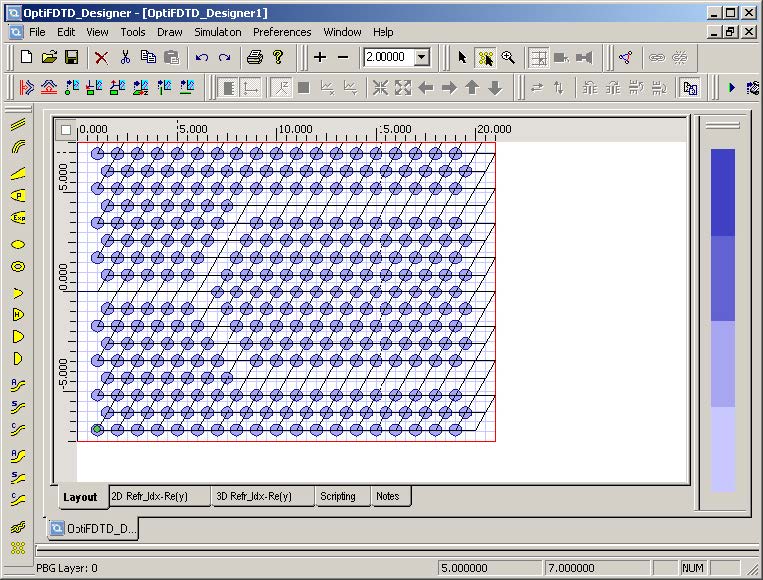

This approach is based on an FDTD simulation concept for creating the matrices containing probability density distributions that are needed for the FDTD-RT interface simulations by using broadband frequency sources. In this contribution we present and discuss a method to reduce the simulation effort and time consumption of this interface simulation process.

In our previous work we already introduced an interface method that uses the Poynting vector to bridge between classical Ray-Tracing and the Finite-Difference-Time-Domain method to enable the simulation of suchlike devices. For this reason, a complete optical simulation of multi-scale devices can only be conducted by combining different simulation methods. Unfortunately, applications of common optical simulation methods are usually restricted to particular size regimes. Project is developed at Department of Nanometrology, Czech Metrology Institute,ĮURAMET joint research projects "Scatterometry" and "Raman" receiving funding from the European Community's Seventh Framework Programme, ERA-NET Plus, under Grant Agreement No.The development of photonic multi-scale devices with tailor-made optical properties requires the control and the manipulation of light propagation within structures of different length scales, ranging from sub-wavelength to macroscopic dimensions. FDTD solves Maxwell’s equations directly without any physical approximation, and the maximum problem size is limited only by the extent of the computing power available. Petr Klapetek, pklapetek(at)cmi(dot)cz Acknowledgements The Finite-Difference Time-Domain (FDTD) method is a rigorous and powerful tool for modeling nano-scale optical devices. Periodic near-to-far field transform was added and many bugs were fixed. Focused light source was added and focused light source and periodic NFFF were implemented on GPU. Significant speedup on CPUĪnd a slight speedup of some algorithms on GPU was achieved.
#Free fdtd free#
The Free Space Padding (In Cells) window enables you to define the extent. Optical force calculation was introduced and the Debye and critical point model media now work on GPU. For more information about exceptions to the general rules, see Grid Appendix (fdtd). A bug in tetrahedron loading was corrected and layered TSF and layered focused TSF were implemented (CPU only).
#Free fdtd windows#
Bugreports are welcome!Ī bug fix for Windows OS was released. It is the first release with XSvit - parametr file viewer and GSvit launcher. One small step for mankind, one giant leap for GSvit. Piecewise Linear Recursive Convolution and Auxiliary Differential Equations method were added. Versioning was changed to three number format. We invite all the fans of Scanning Probe Microscopy to our SPM workshop, March 25-27th in Lednice, Czech Republic This was corrected now and the link is connected with the newer 1.8.1 version.
#Free fdtd software#
The interactive FDTD toolbox is a simulation software to model and simulate two dimensional.
#Free fdtd download#
Please note that the link for download of Windows version wasn't updated and it was still connected with the older 1.8 version. With the freely available interactive FDTD toolbox you can simulate and visualize the electromagnetic field in a structured material such as a photonic crystals, waveguides or investigate refraction at dielectric boundaries and diffraction in free space. Parameters can be changed in a separated window instead of dialog windows.

Since version 1.6 also a graphical user interface XSvit is provided, useful for parameter files setup and visualisation: Newsĭocumentation was switched to DokuWiki system. Theory, Formulation & Implementation of 2D FDTD (free content) Theory, formulation & implementation. Of the algorithms, but seems to be converging. This process is rather slow, at least for some Klapetek et al: Rough surface scattering simulations using graphics cards, Applied Surface Science, 2010, 256, pp 5640-5643. Valtr: Near-field optical microscopy simulations using graphics processing units, Surf. Main mission of this project is to convert set of already developed software tools However, as FDTD is an universal method, it can be used for any other purposes. Optical microscopy, tip enhanced Raman scattering, rough surface scattering, etc. This book explains the use of the high-precision finite difference time domain (FDTD) method to solve new problems in photonics and electromagnetic research. Purposes include research in nanotechnology and nanoscale optics, like scanning near-field Supporting use of Nvidia CUDA environment compatible graphics cards. GSvit covers set of numerical tools for Finite Difference in Time Domain calculations


 0 kommentar(er)
0 kommentar(er)
